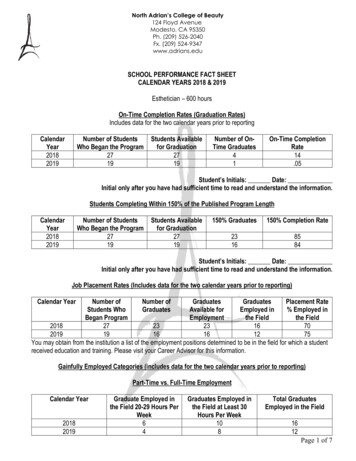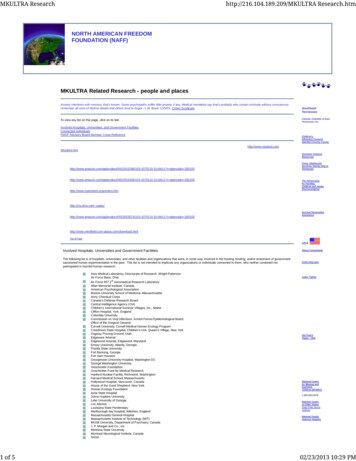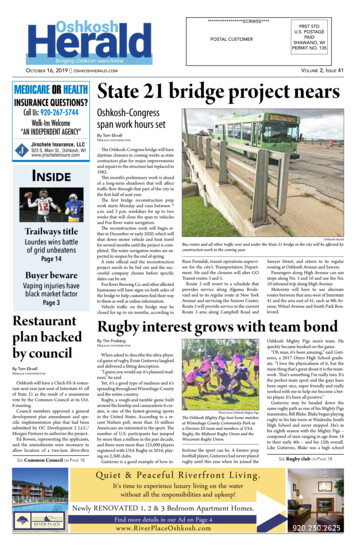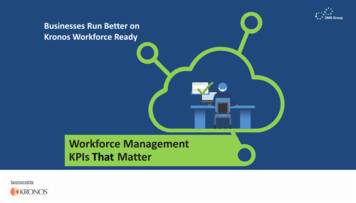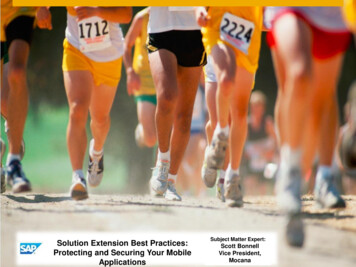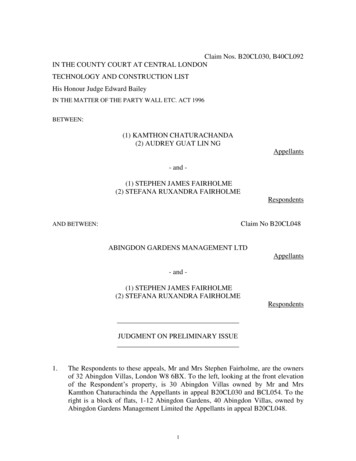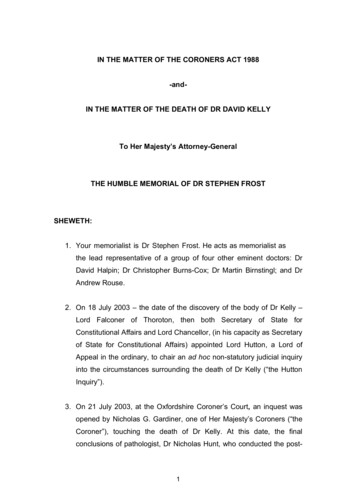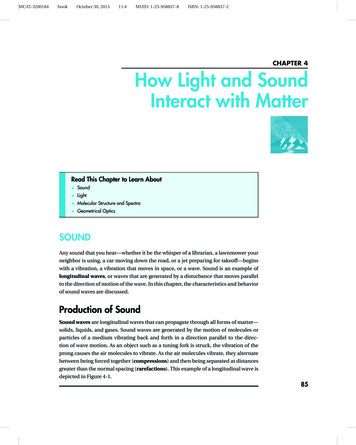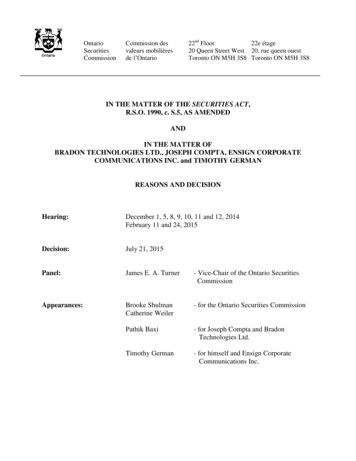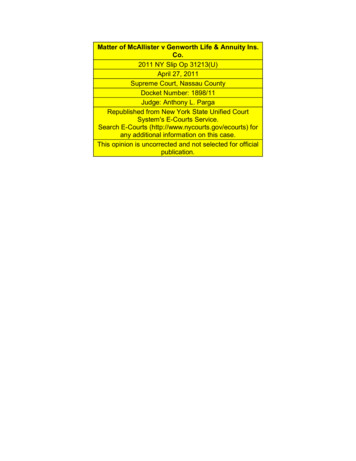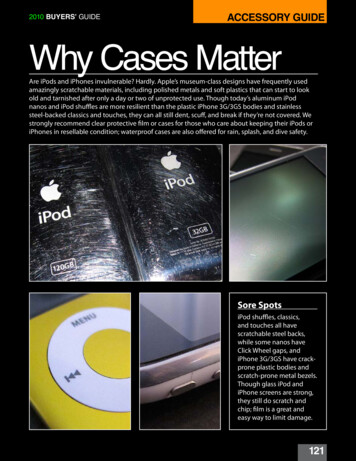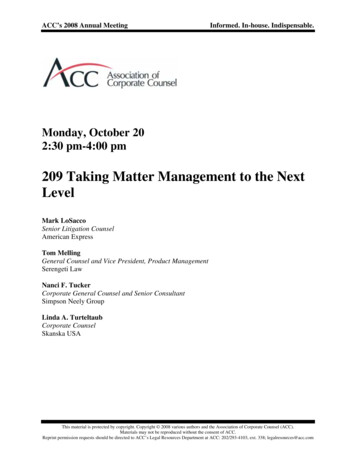
Transcription
ACC’s 2008 Annual MeetingInformed. In-house. Indispensable.Monday, October 202:30 pm-4:00 pm209 Taking Matter Management to the NextLevelMark LoSaccoSenior Litigation CounselAmerican ExpressTom MellingGeneral Counsel and Vice President, Product ManagementSerengeti LawNanci F. TuckerCorporate General Counsel and Senior ConsultantSimpson Neely GroupLinda A. TurteltaubCorporate CounselSkanska USAThis material is protected by copyright. Copyright 2008 various authors and the Association of Corporate Counsel (ACC).Materials may not be reproduced without the consent of ACC.Reprint permission requests should be directed to ACC’s Legal Resources Department at ACC: 202/293-4103, ext. 338; legalresources@acc.com
Informed. In-house. Indispensable.ACC's 2008 Annual MeetingFaculty BiographiesMark LoSaccoas in-house counsel to help other lawyers assess their use of current technology anddetermine expectations and requirements for new systems. Ms. Tucker is also active inassessing the processes surrounding the use of technology and identifying specific areasfor improvement.Mark LoSacco is the senior litigation counsel for American Express in New York. In hiscurrent role, Mr. LoSacco manages all domestic, and certain international, litigation forAmerican Express and its affiliates and subsidiaries. During Mr. LoSacco’s first fiveyears at this position, the American Express Litigation Group has twice been recognizedas a “Top Ten Most Innovative Legal Department” by Inside Counsel magazine.Prior to joining Simpson Neely Group, Ms. Tucker served as the associate generalcounsel for Guaranty Bank, an indirect subsidiary of Temple-Inland Inc., a Fortune 500company. Her practice involved partnering with business managers to provide counsel ona wide variety of business operation, corporate governance, contract and regulatorycompliance issues.Prior to joining American Express, Mr. LoSacco was in private practice for 11 years withLeBoeuf, Lamb, Greene & MacRae. At LeBoeuf, Mr. LoSacco specialized in complexcommercial and banking litigation, including class action defense, where he regularlyappeared in the federal and state courts of New York and New Jersey on behalf of clientsin the financial services industry.Ms. Tucker holds a BA from the University of Colorado and is a graduate of theUniversity of Houston Law Center.Mr. LoSacco is a graduate of Rutgers Law School.Tom MellingTom Melling is vice president for product management and general counsel for SerengetiLaw in Bellevue, WA. Mr. Melling is responsible for the design of the latest functionalityin Serengeti’s matter management/e-billing system, which is currently used by over90,000 legal professionals in 160 countries worldwide. Mr. Melling’s duties also includethe management of configurable templates for tracking different types of legal work,automated currency conversions, and online accrual capture of unbilled law firm time.Additionally, Mr. Melling oversees the team that has implemented Serengeti’s mattermanagement system in more than 200 law departments, and all of their law firms. Hepersonally led the implementation of matter management systems at some of the world’slargest law departments, including Alcatel/Lucent, American Express, and Disney.Prior to joining Serengeti, Mr. Melling practiced law at Perkins Coie in Seattle. His workemphasized Internet and e-commerce law, specializing in electronic contracting, publickey infrastructures, encryption, and data protection.Linda A. TurteltaubLinda A. Turteltaub is corporate counsel for Skanska USA Building Inc., in Parsippany,NJ. Ms. Turteltaub is responsible for developing, implementing and overseeing theadministration of a legal management system to track all legal matters handled by outsidecounsel throughout the United States. The legal management system implemented by Ms.Turteltaub facilitates the management of litigation including tracking legal costs, status oflitigations, budgets, and receipt of service of process. Ms. Turteltaub utilizes the systemto analyze the company’s financial exposure to claims, manage the audit process withoutside auditors, and to supervise the preparation of internal analysis reports.Prior to joining Skanska, Ms. Turteltaub practiced construction law for 12 years in NewJersey, New York and Massachusetts. Before commencing her legal career, Ms.Turteltaub was employed in the construction industry for eight years as an estimator,project engineer and project planner.Ms. Turteltaub received her BA from Texas A&M University and is a graduate ofSuffolk University Law School.Mr. Melling received a BA from Brown University, graduating magna cum laude and PhiBeta Kappa. Mr. Melling is also a graduate of Stanford Law School, where he was amember of the Stanford Law Review.Nanci TuckerNanci Tucker serves as corporate counsel and senior consultant with Simpson NeelyGroup, Inc. in Coldspring, TX. Her primary role is to assist corporate legal departmentsin their selection and implementation of matter management, electronic invoicing,document management and contract management systems. She leverages her experience2 of 13
Informed. In-house. Indispensable.ACC's 2008 Annual MeetingTopics ! Matter Management – The Big PictureReasons for Using a Matter Management System–! Reasons for Using a Matter Management System–! Review of Functionality ! Increase Knowledge ! Are You Obtaining The Most From Your System? ! Increase Productivity–!–!–!–!Imposing Requirements On Law Firms100% Commitment From Law DepartmentUtilizing the System to Support Your CompanyPartially Completed Implementation ! The Value Of Full Implementation of Matter Management System ! Reduce Legal Spend ! Reduce Legal Risk–! Reporting and “Macro Matter Management”–! Obtaining quality data (i.e. avoiding “garbage in, garbage out”) ! New functionalities–! Service of Process–! Accruals ! Do You Know How to Optimize Your System’s Benefits?“Matter Management” Functionality ! Matter Tracking ! Litigation ManagementMatter Management:The Big Picture–! Service of Process management–! Case tracking (plaintiffs, etc.)–! Case assessment memos–! FAS 5 contingent liability estimate–! Trial strategy memos ! Calendar & Contact Integration ! Searching & Reporting ! Remote Access by OutsideCounsel & Law DepartmentAdditional Features !E-Billing–! Automated workflow & validations–! Law firm / Law Dept. budgeting–! Accruals (unbilled amounts from firms) !Document Management !Contract Management !Workflows !Physical File Management !Internal Time Entry !Outside Counsel PerformanceEvaluationsTrend: Combine functionality to achieve fully electronic legal file and processes.3 of 13
Informed. In-house. Indispensable.ACC's 2008 Annual Meeting100% Commitment from Law Department ! Commitment to 100% adoption of the legalmanagement system by the law departmentAre You Obtaining The Most From Your System? ! Allocation of sufficient time and resources for theprocess ! Planning and customizing the system to yourcompany’s needs and goalsNot just a billing systemImposing Requirements on Law Firms ! Billing electronically ! Billing in LEDES format ! Posting status reports ! Submitting budgets ! Submitting Case Assessment Memos ! Estimating liability or recovery in claims or litigation ! Posting events or diary such as trial dates, answers dueUtilizing the System to Support Company ! Support to Marketing Department ! Support to Operations ! Support to Accounting Department ! Outside auditors ! Claims analysis ! Reports to Parent Company ! Material Claims4 of 13
Informed. In-house. Indispensable.ACC's 2008 Annual MeetingPartially Completed Implementation ! Problem: Half in electronic world, half in paper world–! 100% of firms not submitting electronic invoices–! Some matters/offices not on system ! Stage 1 complete; Never complete other stages–! Most law departments first implement eBilling–! Never get around to implementing other functionality, such as lawdepartment budgeting, documents, etc.The Value of Full Implementation of MatterManagement System:Reporting5 of 13
ACC's 2008 Annual MeetingInformed. In-house. Indispensable.Example: Reports for Litigation Management ! Outside counsel is notified at outset of case ofuniform requirements to post initial case assessmentdata in the system within 30 days ! Two key components of initial case assessment: (1)reasonable estimate of exposure, and (2) budget forcurrent year (system automatically passes budget toin-house counsel for approval, rejection, or revision) ! System will not allow counsel to submit invoiceswithout budget, so invoices will not be paid untilcounsel submits exposure and budget informationActual to Budget ReportReporting and “Macro Matter Management” ! Aggregate view of actual spending compared to total budget (not pictured) ! Micro view—actual spending versus each case budget (shown below) ! Important in gauging whether law firms have exceeded case budgets(invoices are not paid without budget or if budget exceeded) ! Allows company to see when last invoice was posted and bring to outsidecounsel’s attention when they are behind6 of 13
Informed. In-house. Indispensable.ACC's 2008 Annual MeetingBudget/Exposure Comparison Report ! Compares each case’s full-year budget to its estimated amount ofexposure ! Helpful when it comes to discussing strategy with outside counsel whenyearly budget and exposure numbers are not making senseOther Simple Reports ! Exposure reports: Sort cases by exposure,highlighting matters that offer significant risk ! Budget reports: Sort cases by budget, highlightingmatters with significant projected outside counselspend ! Spend reports: Sort cases by spend (yearly and lifeof matter), highlighting matters of significant costIncremental Report ! Snapshot of new invoices that have come in the door within theprior seven (7) days ! A trailing indicator of increased activity in a matter, and the “lastline of defense” in highlighting cases that require attentionKey Points in Use of Macro Matter Management ! “Garbage In/Garbage Out”–! Must ensure that directions to outside counsel regarding input intomatter management system are clear and consistent–! Tying payment of invoices to input of key information provides outsidecounsel with strong incentive to comply–! Inside counsel must monitor intake of matters to ensure data entered ! Use of key numerical data points relating to cost of defense andreasonable estimate of exposure permits effective “triage” ofroutine caseload ! Highlighting cases requiring active management by inside counsel,including cases appropriate for early settlement, greatly assists ineffective allocation of limited in-house resources7 of 13
ACC's 2008 Annual MeetingInformed. In-house. Indispensable.“Intake User” Reviews New SOPNew Functionality:Service of ProcessKey Components of SOP Functionality ! Automated processes–! Hourly retrieval of SOP records from SOP vendor–! Email notification of SOPIntake User Moves Record to Matter ! SOP record can be moved to an existing matter or to a new matter.–! If moved to a new matter, the metadata in the SOP record is used to prepopulate matter fields (e.g. court, state, docket number, etc.).–! Alerts for problems with retrieval from SOP vendor–! Automated routing to matters available ! E.g. Automatic routing of all garnishments to a specific matter ! Management of SOP documents–! SOP Intake User creates new matter OR moves document to existing matter–! Ability to enter SOP records manually–! Can set email alerts when an SOP response is due ! SOP Audit Log–! Entire audit history of all actions are automatically captured and reportable8 of 13
Informed. In-house. Indispensable.ACC's 2008 Annual MeetingWorkflow for AccrualsNew Functionality:Accruals(Unbilled Amounts from Firms)Why Generate Accruals in a Matter Management System? ! System automatically sends notice to firms when unbilled amounts aredue ! Firms enter unbilled amounts–! Company users can enter unbilled amounts on behalf of firms, but why nothave firms enter the data? ! Optional – Company review of unbilled amounts ! Accrual is generated and locked in the systemTracking Spending Against Accruals ! Important element of financial reporting (SOX) ! Helps GC better forecast against Law Department Budget ! Logical extension of ebilling–! Firms can submit invoices, why not unbilled amounts? ! Eliminate burdensome paper process9 of 13
Informed. In-house. Indispensable.ACC's 2008 Annual MeetingDriving an Effective Matter Management SystemA Roadmap to OptimizationI recently sold my old car and bought a new one. Although my first choice had been a good one, I hadnot foreseen the growing needs of my family, the increase in gas prices or the fact that I would move to amountain community where all-wheel drive was essential. Because there was no way to modify myvehicle to meet my present-day needs, I had no choice but to replace it.Do You Know How to OptimizeYour System’s Benefits?In the same way, many law departments purchased matter management systems at a time when futureconditions could not be predicted. Their law department was smaller. E-billing wasn’t available.Sarbanes-Oxley and a host of other regulations were not in place. Yet most law departments continue touse their original system in the same way that they used it on the day it was implemented. This approachcommonly contributes to user frustration and certainly doesn’t promote the efficiencies that a mattermanagement system can facilitate.Don’t get me wrong - unlike the purchase of a new car, investment in a new matter management systemis not always the answer. Underperforming systems are never entirely attributable to deficiencies in theunderlying technology. The more culpable contributors are undefined processes and unfocused usagepractices.Whether you drive a “classic” or a new model, here is the question that will continually resurface: what isthe best way use your system to drive cost reduction, achieve higher performance and improve the lawdepartment’s overall effectiveness?The Optimization ModelThe solution comes in the form of two exercises. The first is to define (and to continually redefine) theobjectives that your law department wants to achieve through its use of the system. In the illustrationbelow, the Objectives box is the vehicle taking the law department to its desired destination. Identifyingyour organization’s specific objectives is the first step in charting your course to improved performance.The second exercise is to champion a lifecycle management program that will improve both the systemand your use of the system. In the illustration below, there are four core initiatives which will makeimprovement possible. A taskforce will drive the initiatives, and with them, your objectives for the system.www.simpsonneelygroup.comDriving An EffectiveMatter ManagementSystemPerformanceMetricsData Entry &Quality ControlObjectives1.! Increased Knowledge2.! Increased Productivity3.! Expense Reduction4. Risk ReductionFeedback &ImprovementsSystem Design& Reporting10 of 13
ACC's 2008 Annual Meeting“WHERE ARE WE GOING?” - DEFINING YOUR OBJECTIVESLet’s begin discussing your objectives. There are four interrelated objectives that most lawdepartments target when implementing a matter management system. When you first purchased yoursystem, you could only imagine the returns your department would generate once it was up and running.Now that the system is in place, you must go beyond imagination and define what you want toaccomplish. Does every user clearly understand the benefits gained by using your matter managementsystem? If not, user participation will be minimal, and so will your benefits.1. Increased KnowledgeLaw departments readily understand the concept and value of a central information repository. Arelatively permanent repository maintains institutional knowledge despite the comings and goings ofindividuals within the organization. It also enables your law department to report on legal activities andcosts over a period of years, providing particular value to corporate counsel with department oversight.Accumulated matter information enables counsel to monitor the overall performance of the department,the performance of individuals and the progress of matters. Managing counsel can use information todetermine whether the department is working effectively and to plan strategies to maximize efficiencies,for example, by adding staff and assigning work to align with individual competencies.Where the system incorporates financial management tools such as electronic invoicing or “E-billing”,counsel can more readily forecast law department budgets and comply with financial reportingobligations.In the litigation arena, a knowledge repository is invaluable for case tracking and litigation strategies.Systems with E-billing functionality enable counsel to track law firm expenses, upload and monitorbudgets and evaluate outside counsel performance.General Counsel can also use matter management systems to communicate and market the legaldepartment’s contributions. Many prepare reports on the performance of the law department for thecompany's senior management and board of directors.There are a broad array of possibilities and every law department owes it to themselves to explore how itcan expand on the knowledge capabilities of its matter management system.2. Increased ProductivityMatter management systems enable law departments to save time and drive increased productivity.They offer immediate access to key information about legal projects, litigated matters, internal andexternal contacts, bills and budgets. When the law department can reduce the time spent searching forinformation and/or manually creating reports, it frees them up to be more productive. This can positivelyaffect the law department’s budget where counsel and staff can handle more work internally and sendless overflow work to outside counsel.Matter information can also facilitate the transfer of legal and organizational knowledge from more highlyskilled (and more expensive) attorneys to less experienced (and less costly) lawyers and paralegals.In the same way, systems can enable law departments to push work out of the law department to otherparts of the company. For example, if your matter management system houses information aboutcorporate entities, business clients can be provided with controlled access to view basic informationwithout involving the law department at all. Similarly, the system can enable business clients and relateddepartments such as purchasing, ethics and compliance to access contract templates and othermaterials, allowing them to initiate basic functions, with more extensive legal review to follow as needed.Because most contracts and documents are based on precedent contained in work that has beenpreviously completed, matter management systems dramatically enhance productivity when used by staffInformed. In-house. Indispensable.to access and re-use work product of co-workers and outside counsel. Most matter managementsystems include document storage or linking functions that permit users to attach or link documents tospecific matters. However, the widespread use of this function depends on the number of steps involvedin attaching or linking documents and the ease with which documents can be located and retrieved.Where matter management document storage functions are not adopted, law departments often considerthe integration of a separate document management system. The value of these systems is their abilityto seamlessly capture, store and manage prior work product, templates and other documents developedby the law department and outside counsel. They also employ version control features that are valuablein managing multiple document revisions. With the advent of state and federal regulations that imposedocument management requirements, the popularity of these systems is increasing. Their integrationwith matter management sy
Additionally, Mr. Melling oversees the team that has implemented Serengeti’s matter management system in more than 200 law departments, and all of their law firms. He personally led the implementation of matter management systems at some of the world’s largest law departments, including Alcatel/Lucent, American Express, and Disney.
